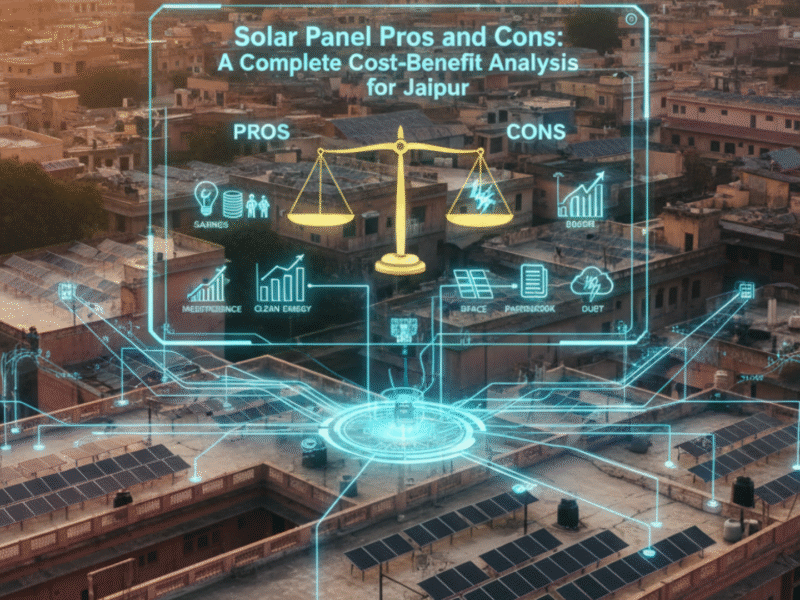
The sun-drenched city of Jaipur, the capital of Rajasthan, is a prime location for harvesting solar energy. With over 325 clear, sunny days annually, the solar potential here is immense, averaging between 5.5 to 6.0 kWh/m² per day. Consequently, an investment in a rooftop solar system is increasingly being viewed not just as an environmental choice, but as a strategic financial decision for homeowners and businesses alike.Understanding the Pros and Cons of Solar Panels is crucial for anyone considering this shift.
However, before making such a significant commitment, a thorough understanding of the Pros and Cons of Solar Panels is absolutely essential. This comprehensive cost-benefit analysis will systematically break down the investment, the returns, and the unique challenges faced by residents of Jaipur and the wider Rajasthan region, ensuring you have all the facts necessary to make an informed decision.
The Economics of Solar: A Cost-Benefit Analysis in Jaipur
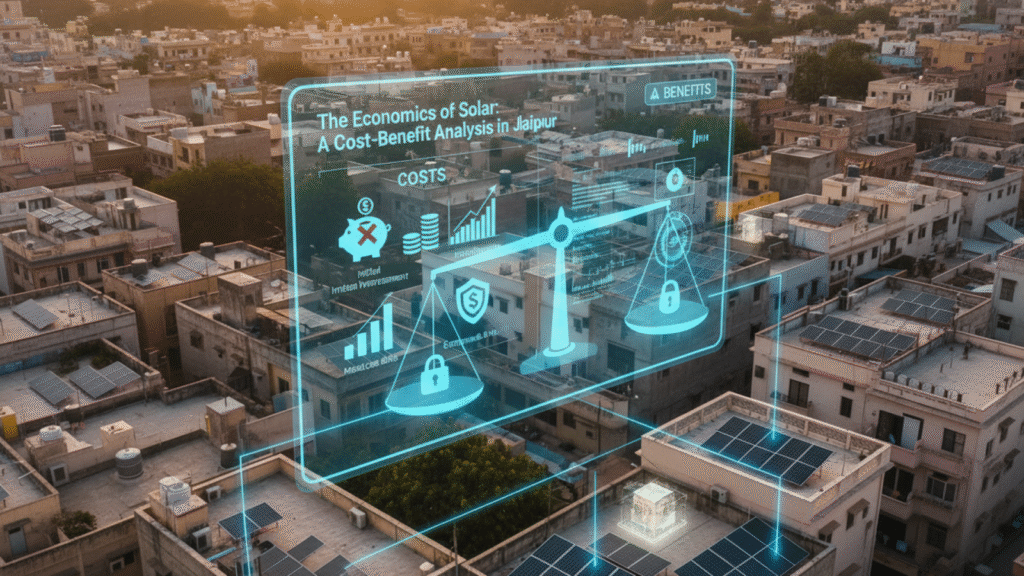
The decision to go solar hinges on one core question: does the long-term financial gain justify the initial outlay? In Jaipur, the answer is leaning strongly towards yes, thanks to substantial government support and escalating electricity tariffs.
Pros and Cons of Solar Panels: The Upfront Investment and Cost Breakdown
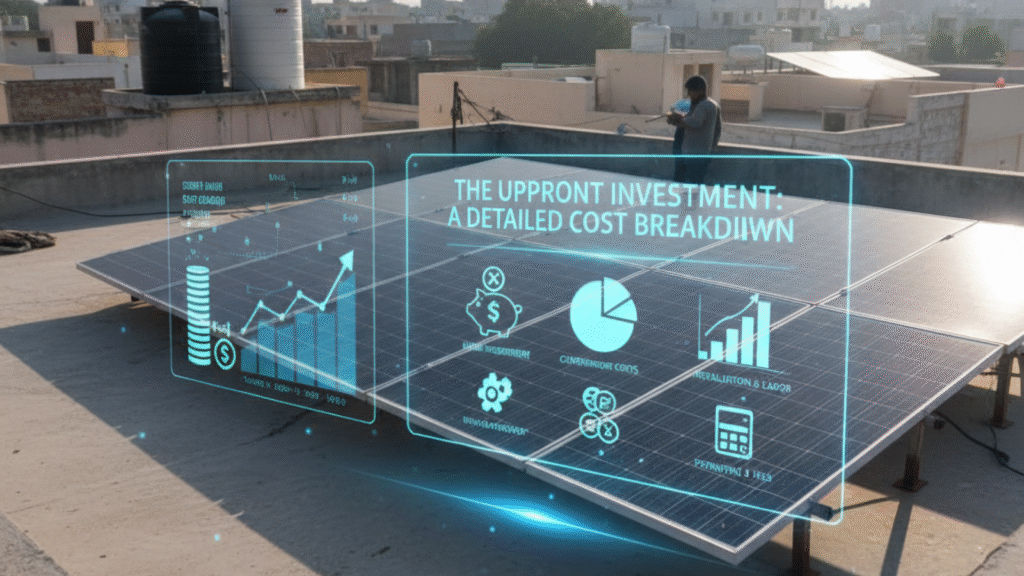
The initial cost is the single largest barrier for most potential solar adopters. The total price for a rooftop system in Jaipur depends on the size (in kW), the type of components (Mono PERC, TOPCon panels), and the system configuration (on-grid, off-grid, or hybrid).
Jaipur Solar System Price Range (Indicative, Before Subsidy)
| System Size (kW) | Typical Monthly Consumption (Units) | Approx. Price Range (₹) |
| 1 kW | 100 – 150 | ₹75,000 – ₹90,000 |
| 3 kW | 300 – 450 | ₹1,90,000 – 2,30,000 |
| 5 kW | 500 – 750 | ₹3,20,000 – ₹3,80,000 |
Table 1: Indicative Solar System Costs in Jaipur (Before Subsidy, On-Grid Residential System)
It is important to note that these prices are merely indicative and are subject to change based on vendor, brand, and installation specifics.
Maximising the Benefits: Subsidies and Financial Incentives
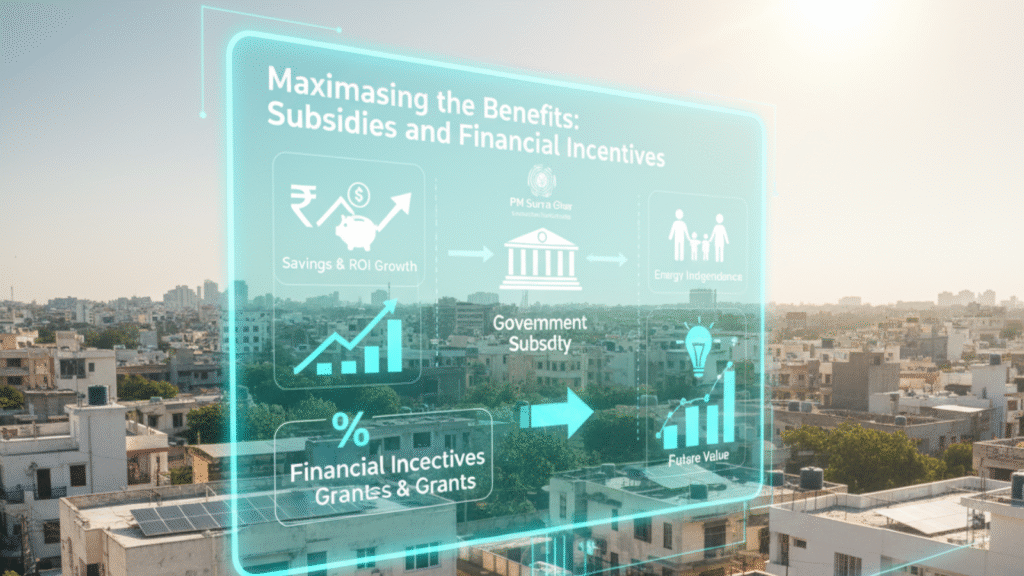
The central government’s PM Surya Ghar: Muft Bijli Yojana is a game-changer, dramatically reducing the effective installation cost and accelerating the return on investment (ROI).
PM Surya Ghar Scheme Subsidy Structure (2025)
| System Size (kW) | Central Subsidy (₹) | Effective Price Range (₹) After Subsidy |
| 1 kW | ₹30,000 | ₹45,000 – ₹60,000 |
| 2 kW | ₹60,000 | ₹80,000 – ₹1,10,000 |
| 3 kW & Above (Max 10 kW) | ₹78,000 (Maximum Cap) | ₹1,12,000 – ₹1,52,000 (for 3 kW) |
Table 2: Estimated Costs After Central Subsidy for Residential Rooftop Solar in Jaipur
This significant financial assistance effectively makes solar power accessible to a much broader section of society. For a typical 3 kW system, the subsidy covers a substantial portion of the total cost, bringing the final out-of-pocket expense down to a highly competitive level.
The Pros and Cons of Solar Panels for Jaipur Residents
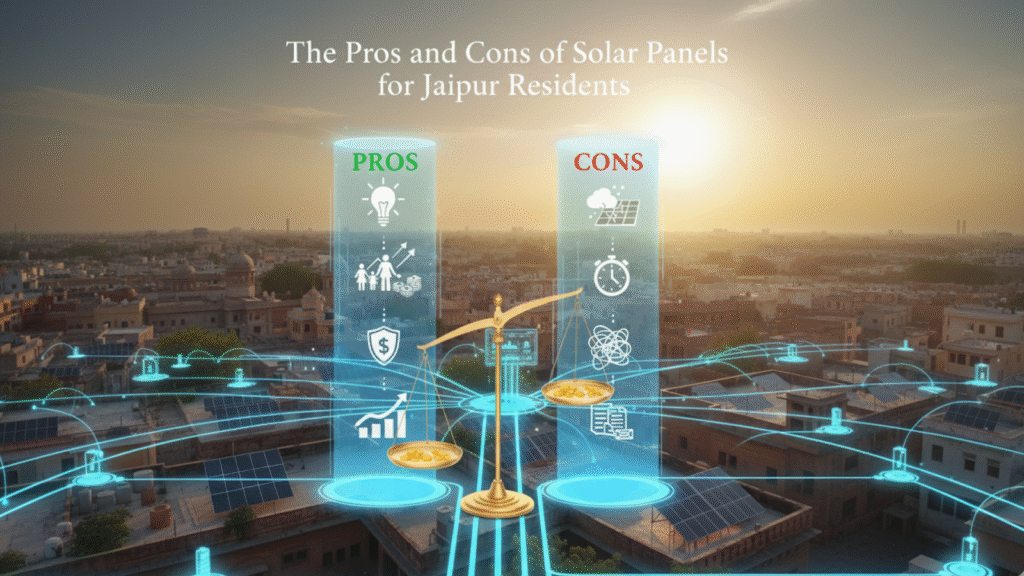
A balanced assessment requires a clear look at both the compelling advantages and the practical drawbacks of adopting this technology.
The Pros of Going Solar in the Pink City
1. Drastic Reduction in Electricity Bills
This is, unquestionably, the primary motivator. With an on-grid system and net metering, homeowners can offset 70% to 90% of their monthly electricity consumption. Rajasthan’s grid policy allows users to receive credit for surplus power exported to the grid, meaning that highly efficient systems can result in negligible or even zero monthly electricity bills. The guaranteed 300 units of free electricity per month for systems up to 3 kW under the PM Surya Ghar scheme further enhances this financial benefit.
2. Excellent Return on Investment (ROI)
Given the high solar irradiation and generous subsidies, the payback period for a residential solar system in Jaipur is remarkably short, typically ranging from 4 to 6 years. Once the investment is recovered, the electricity generated for the remaining 20+ years of the panel’s lifespan is essentially free. A 3 kW system, for example, is estimated to save over ₹10 lakh over its 25-year lifespan, providing an astonishing 10x return on the post-subsidy investment.
3. Environmental and Energy Independence
By using the sun’s clean, renewable energy, homeowners actively reduce their carbon footprint, contributing to India’s climate goals. Furthermore, solar panels offer protection against volatile grid electricity price hikes, granting long-term energy independence.
4. High Property Value
Homes equipped with a fully installed and operational solar system are increasingly valued higher in the real estate market. Potential buyers recognize the immediate and long-term savings on electricity, effectively increasing the property’s resale value.
The Cons and Challenges of Solar in Jaipur
1. High Upfront Cost
Despite the subsidies, the initial capital expenditure remains significant. For larger systems (5 kW and above), the cost can still run into several lakhs, necessitating careful financial planning, which might include seeking low-interest green loans.
2. Space and Aesthetic Constraints
A typical 1 kW system requires approximately 100 square feet of shadow-free rooftop space. Larger residential systems (3 kW or 5 kW) require considerable roof area, which can be challenging for homes with limited or complex roof structures. Additionally, some homeowners may find the large panels aesthetically unpleasing.
3. Dust and Heat Impact on Performance
Jaipur’s arid climate, characterised by frequent dust storms, necessitates regular panel cleaning. Dust accumulation can significantly reduce efficiency. Moreover, while Jaipur has abundant sun, Rajasthan’s intense summer heat can paradoxically slightly reduce the efficiency of standard panels. Modern technology, such as TOPCon or Mono PERC panels, mitigates this, but efficiency still generally peaks at cooler temperatures.
4. Regulatory and Discom Hurdles
While the government has streamlined processes, navigating the paperwork for the subsidy application and the mandatory net-metering connection with the local distribution company (JVVNL) can still be complex and time-consuming. Delays in inspection and net-meter installation are common administrative bottlenecks that can frustrate new adopters.
The Practical Installation Process and Maintenance
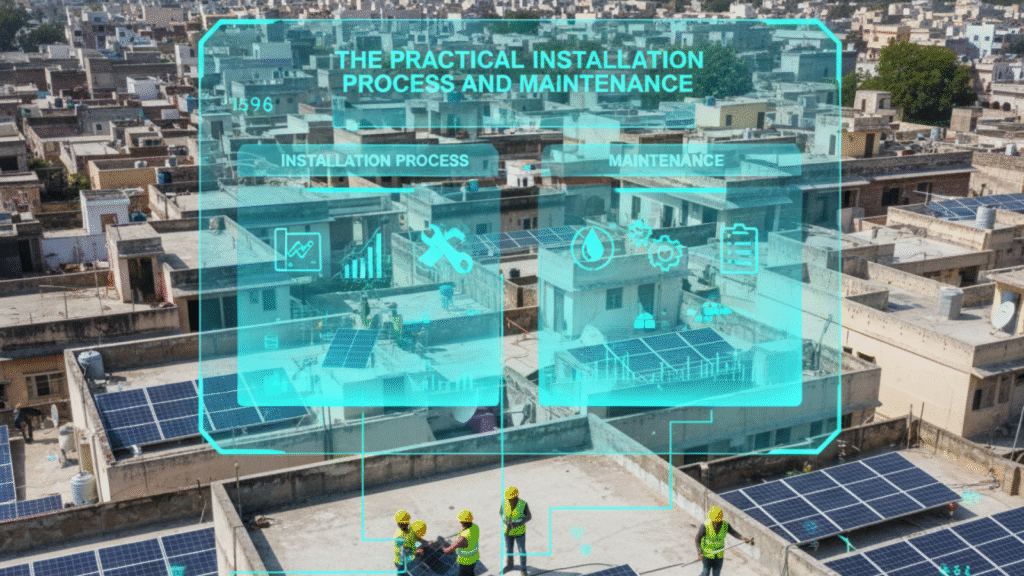
A crucial element of the cost-benefit equation is the operational life and maintenance of the system.
Solar Panel Maintenance
Solar systems are inherently low-maintenance. The panels themselves have a lifespan of 25 years or more, with an annual degradation rate of about 0.5%.
- Cleaning: The most essential task is regular cleaning, especially during the dry, dusty months. This can often be done by the homeowner or a local service provider.
- Inverter Replacement: The inverter, the ‘brain’ of the system, has a shorter lifespan, typically 10 to 15 years, and will need to be replaced once or twice during the panel’s life, representing a mid-term expense.
- Structural Integrity: Given Rajasthan’s occasional high winds, the mounting structure must be robustly engineered and regularly checked to prevent damage.
Net Metering Explained for Jaipur
Net metering is the mechanism that ensures the financial return on your investment. When your panels produce more electricity than you consume, the surplus is automatically exported to the JVVNL grid, and your meter runs backward, earning you credit. Conversely, when your consumption exceeds solar generation (like at night or on cloudy days), you pull electricity from the grid. This crucial policy is what allows for the 70% – 90% bill reduction achieved by most successful on-grid systems in the region.
Conclusion: Weighing the Pros and Cons of Solar Panels in Jaipur
The decision to install a solar system in Jaipur involves weighing a significant initial expenditure against decades of substantial financial and environmental rewards.
Ultimately, the overwhelming evidence suggests that for most homeowners and businesses with adequate, shadow-free roof space, the answer is a resounding yes.
The combination of the state’s natural solar abundance, the substantial PM Surya Ghar subsidy (up to ₹78,000), the excellent net metering policy, and the projected 4-6 year ROI makes solar an incredibly compelling investment. While challenges like initial cost and administrative procedures exist, they are significantly outweighed by the promise of virtually free electricity for over two decades and a substantial increase in long-term property value.
Transitioning to solar power in Jaipur is not just an expense; it is a future-proof investment in energy security, financial freedom, and a cleaner environment.
Frequently Asked Questions (FAQ) Regarding the Pros and Cons of Solar Panels
Q1: How much roof space is required for a 3 kW solar system?
A. A 3 kW solar system, which is ideal for a mid-sized home, typically requires approximately 300-350 square feet of shadow-free area.
Q2: Do I still get electricity during a power cut with an on-grid system?
A. No. Standard on-grid systems are designed to shut down during a grid power outage (JVVNL power cut) for safety reasons, primarily to prevent back-feeding the grid and electrocuting utility workers. To have power backup during an outage, you would need to invest in a pricier off-grid or hybrid system with a battery bank.
Q3: What is the lifespan of solar panels in Jaipur’s climate?
A. High-quality solar panels have a warranted performance lifespan of 25 years. They are designed to withstand high temperatures and wind loads. After 25 years, the panels do not stop working but typically operate at about 80-85% of their original efficiency.
Q4: How long does the subsidy and net metering process take in Jaipur?
A. The total end-to-end process, from application to net meter installation and subsidy disbursement, can take anywhere from 2 to 4 months, depending on the speed of JVVNL inspection and the central portal’s processing time. Choosing an experienced, empanelled installer is crucial for navigating this bureaucratic process efficiently.

